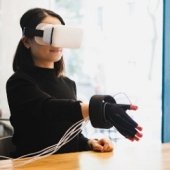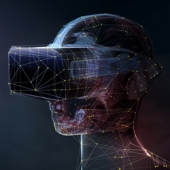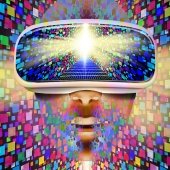The 'learning metaverse’: Cambridge dean envisions a meeting place for business and higher ed
IN BRIEF
- The metaverse promises to improve, perhaps even revolutionize, higher education by making it more immersive, engaging, interactive and interconnected. And the opportunity applies to corporate talent development as well.
- The metaverse is on demand and cost-effective. At a time when many universities are reeling from rising costs and reduced enrollments, the metaverse offers new options that will resonate with students.
- The metaverse could well lead to a more distributed global innovation architecture. Companies that have long sought to locate near sources of research and innovation may now take advantage of such interactions in an unconstrained metaverse.
“If we teach today as we taught yesterday, we rob our children of tomorrow.” So said John Dewey, the U.S. philosopher and education reformer, in 1916. Over the past half-century, education has undergone a series of transformations with the incorporation of new technology, from computers and smart boards to digital libraries and learning platforms. The metaverse may well bring about the next big breakthrough by removing physical constraints from the process of learning. While the deployment of the technology—and the technology itself—is in its early stages, the metaverse promises to improve, perhaps even revolutionize, higher education by making it more immersive, engaging, interactive and interconnected. And the opportunity applies to corporate talent development as well.
Layers of virtual learning
Imagine taking learners’ avatars on a virtual walking tour of an archaeological site, a battlefield, a nuclear reactor or a meeting of a corporate board of directors. We already have the tools to create a learning immersion that text, multimedia content or the internet cannot provide. Now imagine that the avatars can experiment with a variety of “What if?” questions in real time. What if ashes were found next to a skeleton? What if Alexander the Great had never invaded Persia? What if the control rods had not been withdrawn from the reactor core at Chernobyl? What if the board approves a smaller dividend than the market expects? Chatbots will provide preliminary answers to those questions and suggest other content, or even other virtual spaces, in which to explore them further. To the extent that the metaverse can offer alternative scenarios in real time, learners can improve their critical thinking skills, challenging aspects of inherited wisdom as they study science, the humanities or business. This is the initial approach that many universities around the world have taken, often embedded in existing face-to-face classes.
The immersive potential of the metaverse derives from the creation of a dynamic, 3D parallel universe by means of a mix of virtual reality (VR), enhanced reality (ER) and artificial intelligence (AI). Professors know the importance of re-creating the context in which the subject, topic or phenomenon at hand takes place. Traditionally, we would have learners run experiments in the lab, visit an archive, watch a video, listen to a guest speaker or participate in a field trip. The potential of the metaverse lies in creating a new system of learning in which immersion is a central feature. Moreover, the metaverse is on demand and cost-effective. At a time when many universities are reeling from rising costs and reduced enrollments due to demographic change and geopolitical tensions, the metaverse offers new options that also have the advantage of resonating with students.
The second critical step in a metaverse-based learning journey consists of providing tools that enable and motivate learners to engage with the subject and take part in problem-solving. A virtual visit to a slum, for instance, could lead to a planning exercise to build a sewage system. Or learners could work on curating an exhibition of digital art in a virtual gallery they can create themselves. In business school or inside a company, participants can learn about environmental, social and governance matters (ESG) and calibrate in real time the extent to which specific projects would reduce the carbon footprint.
The benefits of immersion and problem-solving can be multiplied many times over through social interaction, the third phase of metaverse learning. Early metaverse technology was developed to enable gamers to join and leave groups of players, regardless of physical location. The always-on character of the metaverse lends itself to spontaneous interactions among learners, whereby they can even create their own virtual study rooms, organize events, and invite speakers or experts. The gamification of learning started a few decades ago with computer-based simulations, which the metaverse and AI can take to new heights. Here lies a key opportunity for universities in general and business schools in particular. Students and employers are attaching more importance to social skills. In the past, these would be developed through teamwork and other face-to-face activities. But in the future, the key will be to develop virtual social skills, especially if shopping and entertainment grow in the metaverse as expected.
To the extent that the metaverse can offer alternative scenarios in real time, learners can improve their critical thinking skills, challenging aspects of inherited wisdom as they study science, the humanities or business.
Finally, the metaverse has the potential of becoming a constellation of interconnected virtual worlds—although at the present time, it is little more than a fragmented collection of platforms, sites, and apps—enabling both teachers and learners to reach out into other virtual communities to exchange knowledge, ideas and perspectives. This feature of the metaverse will prove to be very attractive to business schools as they launch more learning activities and degree programs in collaboration with other business schools and with companies, without having to navigate the constraints of the physical world.
How companies can benefit
It goes without saying that the learning potential of the metaverse applies not just to universities and business schools but also to companies. Large corporations will, in due course, see the benefits of creating a learning metaverse for their employees, offering them 24/7 opportunities for professional development, collective problem-solving and creative thinking. Smaller companies might find it more appealing to participate in an interconnected learning metaverse with other companies and organizations, something that large corporations may also find useful with respect to their suppliers.
Companies that have long sought to locate near sources of research and innovation may now take advantage of such interactions in an unconstrained metaverse. If engineers and scientists can mingle in a metaverse specifically designed to facilitate the sharing of ideas and boost creativity, we might see a fundamental reconfiguration of the geography of technological activity. At the present time, startups and established companies flock to locations believed to be cradles of innovation—and for good reason. Proximity is essential not just to the process of discovery and innovation but to securing the resources needed to grow a business. The metaverse could well lead to a more distributed global innovation architecture.
Each successive layer of immersive, engaging, interactive and interconnected virtual learning will also help companies approach the search-and-hiring process more efficiently. Instead of analog or virtual job interviews, candidates could be evaluated in a purpose-built metaverse where they would be able to demonstrate their skills at framing and solving problems, working in teams or getting things done. This type of recruiting process would also help job seekers figure out if the company and its ways are a good fit for them.
And years before people apply for jobs, the metaverse would enable companies to create virtual spaces in which students from elementary school through university might learn about subjects relevant to the company’s industry or operations. Schools or universities would need to decide which of these spaces would be interconnected with their own metaverse. Thus, the metaverse could provide a new way of bridging the often-significant gap between the skills taught at school and those required by companies.
Proximity is essential not just to the process of discovery and innovation but to securing the resources needed to grow a business. The metaverse could well lead to a more distributed global innovation architecture.
It's time to start experimenting
The metaverse can help address many shortcomings of education as we know it. It can enrich the educational experience by making it more immersive, engaging, interactive and interconnected. It can remove distance and locality as constraints, enabling learners to delve into otherwise inaccessible possibilities. It can help develop better leadership and teamwork skills by facilitating collaboration on problem-solving in real time. And it can align educational institutions and employers and even encourage the exchange of ideas after people begin working for different organizations.While the opportunities are great, the uncertainties concerning the technical standards, interconnectivity and governance of the learning metaverse call for a phased approach in which a long-term vision informs experimentation and the development of the necessary skills for future expansion. As the imponderables recede, we will begin to see who thrives in this new era of learning. Unleashing the potential of the learning metaverse will require much trial and error, learning by doing, and adaptation on the part of the different parts of the ecosystem, from content providers, schools and universities to policymakers, funders and employers. The key takeaway is that the metaverse is not just a new tool to shape the future of learning; it will create an entirely new way of learning.






































